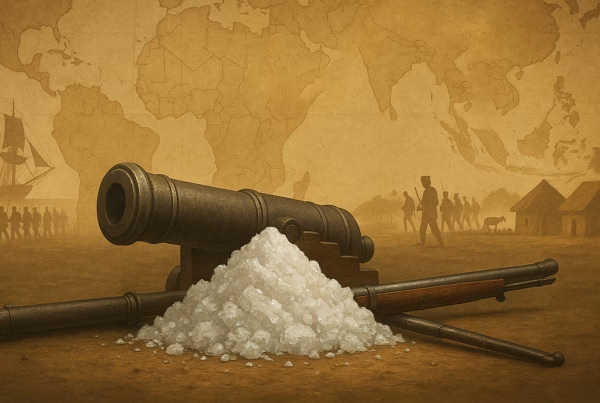On India’s western edge, where the desert melts into the Arabian Sea, lies a narrow strip of tidal water called Sir Creek — a place where geography meets geopolitics, and silence hides a long-standing tension. Here, the wind hums through mangroves, soldiers patrol on speedboats, and tides erase footprints faster than history can remember them.
Few Indians know much about it, yet Sir Creek is one of the most sensitive and disputed boundaries between India and Pakistan — a region where maps blur, tempers rise, and the sea itself refuses to take sides.
The Origin of Sir Creek: A Colonial Blunder
Sir Creek, a 96-kilometer estuary connecting the Great Rann of Kutch to the Arabian Sea, lies between Gujarat, India, and Sindh, Pakistan. Its waters shift with the tides—sometimes a river, sometimes a maze of mudflats and mangroves. Named after Sir Richard Temple, a 19th-century British Governor of Bombay who surveyed the region, Sir Creek is a colonial relic that sparked a modern dispute.
The trouble began in 1914 with the Bombay Resolution, a document signed between the Maharaja of Kutch (under British India) and Sindh (then part of Bombay Presidency). The resolution placed the boundary along the “eastern flank of Sir Creek,” suggesting Sindh owned the entire creek. But the map was vague, with contradictory clauses that sowed confusion. When India and Pakistan emerged from Partition in 1947, this ambiguity became a diplomatic landmine.
Pakistan claims the entire creek, citing the 1914 resolution. India argues the boundary should run through the mid-channel, per international maritime norms for navigable rivers. This disagreement—over a line in the water—has fueled a 75-year cartographic battle that remains unresolved.
Why Is Sir Creek Called Harami Nala?
To locals and soldiers stationed there, Sir Creek is often known by another name — “Harami Nala.” The word harami in Hindi and Urdu means “wicked” or “deceitful,” and the creek earned this name for a reason. The tidal patterns here are unpredictable — the sea rushes in with violent force and retreats without warning, swallowing land, erasing landmarks, and even altering the channel’s course over time. During high tide, the entire area gets flooded; during low tide, it turns into a maze of cracked salt plains and mangroves. For the BSF jawans (India’s Border Security Force) who guard this region, the terrain is among the toughest in India — full of quicksand, venomous scorpions, and bandi snakes. The humid, saline air corrodes equipment and affects health. The word Harami also reflects how treacherous and deceptive the region is — peaceful by sight, perilous in nature.
Why Is Sir Creek Important for India and Pakistan?
At first glance, Sir Creek looks like an uninhabited wasteland — but beneath its muddy waters lies strategic and economic significance that both nations are keenly aware of.
- Fisheries and Livelihoods:
The creek is rich in marine life — home to fish, prawns, and crabs that sustain thousands of fishermen from both sides. But due to the unmarked boundary, fishermen often stray into each other’s waters, leading to frequent arrests and imprisonment. - Maritime Boundary and EEZ (Exclusive Economic Zone):
The biggest reason for the Sir Creek issue is its direct link to the maritime boundary in the Arabian Sea. The way this line is drawn decides each country’s Exclusive Economic Zone — an area extending 200 nautical miles into the sea where they can explore oil, gas, and minerals. Even a small shift of the Sir Creek line can mean thousands of square kilometers of ocean territory gained or lost. - Strategic and Security Importance:
Sir Creek is close to the Kutch coastline, which serves as a gateway to India’s western ports — including Kandla and Mundra, vital for trade and energy imports. For Pakistan, it’s equally important due to its proximity to the Indus Delta and Karachi’s maritime approach. Any incursion here could have serious defense implications.
Ecological Significance:
Beyond politics, the region is an ecological wonder — a fragile mangrove ecosystem that supports migratory birds, saltwater crocodiles, and rare marine flora. It’s part of the Indus Delta–Rann of Kutch wetland system, one of South Asia’s most unique coastal landscapes.
Why Is Sir Creek a Disputed Zone?
After India’s independence and Pakistan’s creation in 1947, the boundary inherited from the British became a matter of interpretation.
- Pakistan’s Stand: The border lies along the eastern bank of Sir Creek, meaning the creek belongs entirely to Pakistan.
- India’s Stand: The boundary should be mid-channel, dividing the creek equally, in line with international law for navigable rivers.
The disagreement intensified after the Indo-Pak war of 1965, which was partly triggered by border tensions in the Rann of Kutch. Although a tribunal settled most of the Rann dispute in 1968, awarding about 90% of the land to India, Sir Creek remained unresolved.
Several rounds of talks have been held since 1969, and even joint surveys were conducted in 2007 to map the area scientifically. Despite this, political mistrust and strategic hesitation have kept the issue frozen.
Sir Creek in 2025: A Frontier on Edge
Today, Sir Creek is a quiet yet heavily patrolled border, but 2025 has brought it back into focus. After Operation Sindoor 2.0 in May, where India targeted terrorist camps in Pakistan, tensions have spiked. Pakistan has increased its drones, ships, and troop presence in the creek, prompting sharp warnings from India. On October 3, 2025, Defence Minister Rajnath Singh declared, “Pakistan must not miscalculate—Sir Creek to Karachi is a short path.” Army Chief General Upendra Dwivedi added, “Sindoor 2.0 won’t pause next time.” Pakistan’s Defense Minister countered, “Any misadventure will lead to devastation.”
The BSF’s Creek Crocodile Commandos are the unsung heroes guarding this frontier. With no fencing or fixed boundary, they brave treacherous conditions daily. During high tide, speedboats navigate turbulent waters; during low tide, jawans trudge through mudflats, dodging bandi snakes and scorpions. When tides are too shallow for boats but too deep for walking, All-Terrain Vehicles (ATVs) glide through marshes. Floating Border Out Posts (BOPs) anchor overnight, while radar tracks every movement. The saline air causes health issues—blood pressure, joint pain, dehydration—yet these jawans remain steadfast, guarding a border that shifts with every wave.
Despite being a disputed zone, Sir Creek rarely makes headlines. It has seen no major skirmish in decades — only the quiet endurance of soldiers and the occasional rescue of fishermen who unknowingly cross the invisible line.
The Forgotten Creek of India
For most Indians, Sir Creek remains The Unknown India — a border you can’t cross, a dispute you rarely hear of, and a landscape few have ever seen. Yet it represents much more than a geopolitical fault line. It is a living symbol of resilience — of men guarding a vanishing border, of tides rewriting maps, and of a land that silently bears witness to decades of unresolved history.
Perhaps one day, Sir Creek will no longer divide two nations, but connect them — as it once did before the lines were drawn. Until then, the “Harami Nala” will continue to whisper its story — of salt, silence, and survival.



